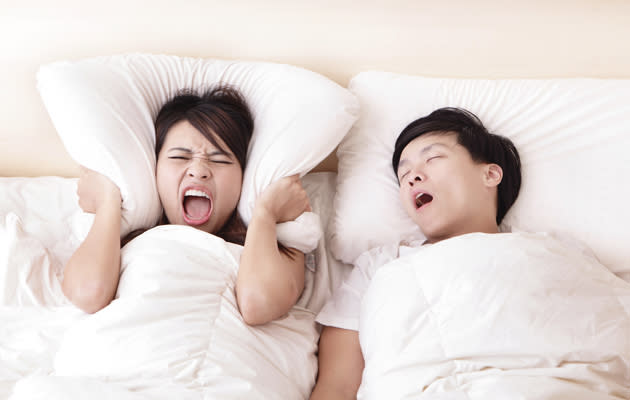Snoring by Night and Sleepy by Day? You May Have Sleep Apnoea
Snoring by Night and Sleepy by Day? You May Have Sleep Apnoea

Snoring can be more than just a nuisance for your bed partner. As a habitual snorer, you could be suffering from a potentially serious sleep disorder called obstructive sleep apnoea (OSA). This condition, which affects up to 15 per cent of adults in Singapore, is marked by frequent awakenings during the night as the person’s breathing gets interrupted.
Dr Toh Song Tar, Consultant, Deputy Head (Research) and Director, Sleep Disorder Unit at the Department of Otolaryngology of Singapore General Hospital (SGH), a member of the SingHealth group, explains the connection between snoring and sleep apnoea, and shares the different snoring treatments.
What causes snoring?
In most people, snoring is due to multiple factors. When you doze off and progress from light sleep to deep sleep, muscle relaxation can narrow the airway, creating airflow turbulence, and allow the soft tissues in your throat to vibrate. If you sleep on your back, your tongue may fall back and contribute to the airway narrowing and snoring.
Enlarged tonsils can also be a cause of snoring in adults, but that’s more often the case in infants and children.
Related article: 7 fast facts about obstructive sleep apnoea
Other reasons that may cause you to snore include:
Gender and weight. Being male and obese are both risk factors for snoring.
Ageing. As we age, the airway muscles become more lax.
Alcohol and certain medications. Consuming alcohol too close to bedtime can induce over-relaxation and collapse of the throat and tongue muscles.
Nasal and sinus problems. If you have chronic nasal congestion or a crooked nose cartilage (also known as a deviated nasal septum), you are more likely to snore.
Mouth anatomy. A low, thick soft palate can narrow your airway during sleep. Similarly, an elongated uvula (the dangling tissue in the back of your mouth) may obstruct airflow.
Snoring and the sleep disorder called sleep apnoea
Snoring is a common symptom of sleep apnoea, a potentially serious sleep disorder where breathing stops many times during sleep. These pauses cut off oxygen supply, forcing you to awaken with a snort as you gasp for air.
A key tell-tale sign is the extreme fatigue and sleepiness experienced the next day – even with sufficient hours of sleep. Other symptoms include depression, irritation, decreased libido and morning headaches.
Studies have shown that untreated sleep apnoea increases the risk of:
High blood pressure
Heart attack
Cardiac arrhythmias
Sudden death
Stroke
Premature death in the long run
Related article: Have you heard of sleep paralysis, a frightening condition that may be triggered by obstructive sleep apnoea?
Snoring treatment
Non-surgical treatments
If you’ve been diagnosed with obstructive sleep apnoea, you will benefit from the use of an apparatus supplying continuous positive airway pressure (CPAP).
CPAP therapy involves wearing a pressurised mask over your nose while you sleep. The mask is attached to a small pump that forces air through your airway to keep it open. Although effective in eliminating snoring and treating sleep apnoea, the device may require some getting used to.
Doctors will also recommend lifestyle changes, including good sleep hygiene, weight loss, limited alcohol intake and smoking cessation. Another option could be the use of a dental splint, which resembles an athlete’s mouth guard and is worn during sleep to open up your airway by bringing forward your jaw and tongue.
Surgical treatments
Surgical procedures for the treatment of snoring may include nasal, palatal, jaw, tongue and neck surgery, depending on the tissues that cause you to snore.
UPPP (uvulopalatopharyngoplasty) – UPPP and variations of this procedure are commonly performed to remove excess tissues in the back of the throat and palate to increase the width of the airway.
Nasal surgery – Removal of bone, cartilage or enlarged tissues interfering with breathing during sleep can encourage normal breathing through the nose and improve obstructive sleep apnoea (OSA).
Hypopharyngeal and base of tongue surgery – When the obstruction stems from the base of the tongue, a surgeon can either increase the airway size or alter the tongue size or tension.
Maxillomandibular advancement surgery – Reserved for severe sleep apnoea patients when all else fails, this procedure involves moving forward the jaw and face bones to give the tongue more room and open up the airway.
Related article: 8 doctor-approved tips on how to stop snoring
Get more health tips at HealthXchange.com.sg and sign up for our FREE e-newsletter.
By Alvin Chumari for HealthXchange.com.sg.
Articles on HealthXchange.com.sg are meant for informational purposes only and cannot replace professional surgical, medical or health advice, examination, diagnosis, or treatment.

